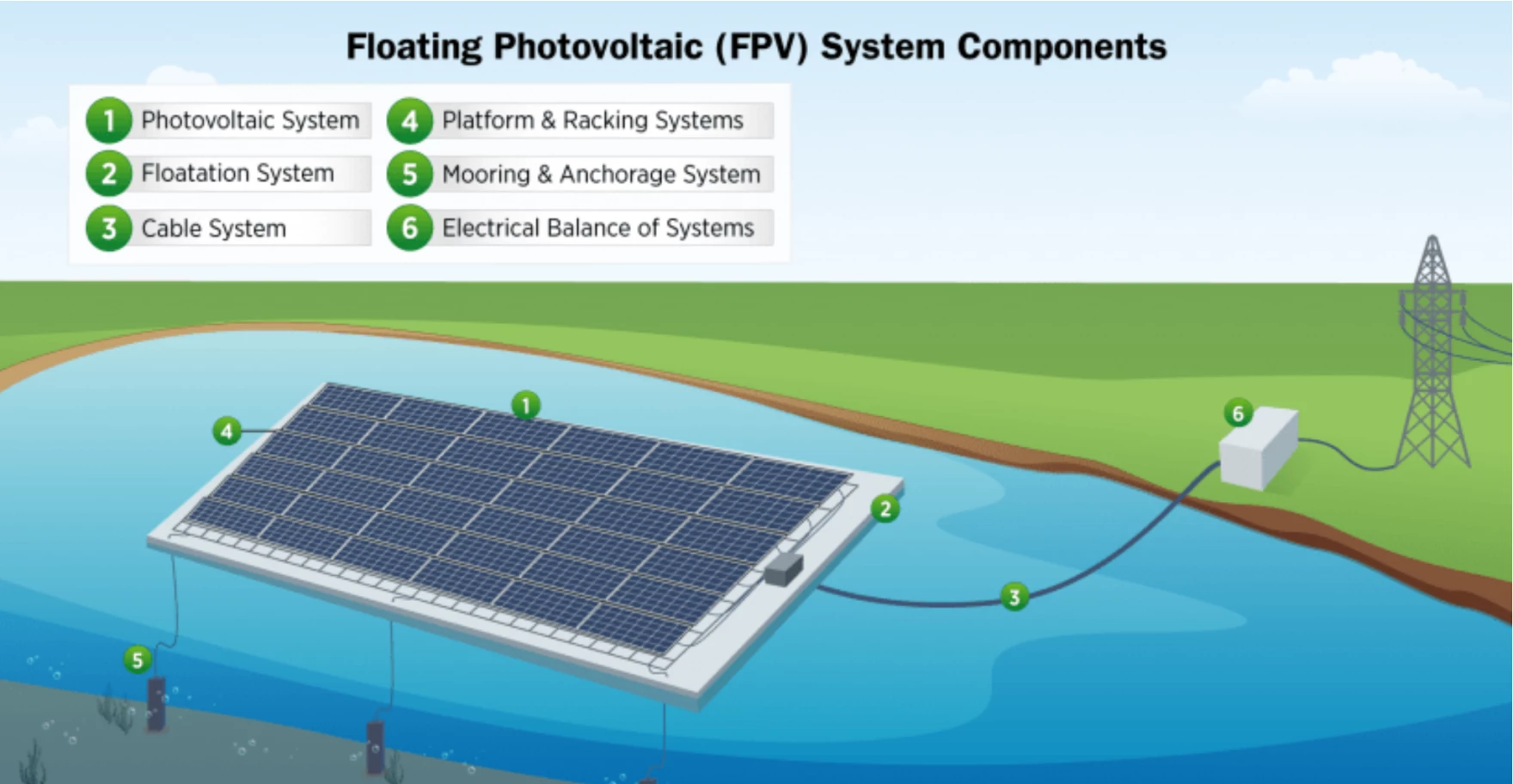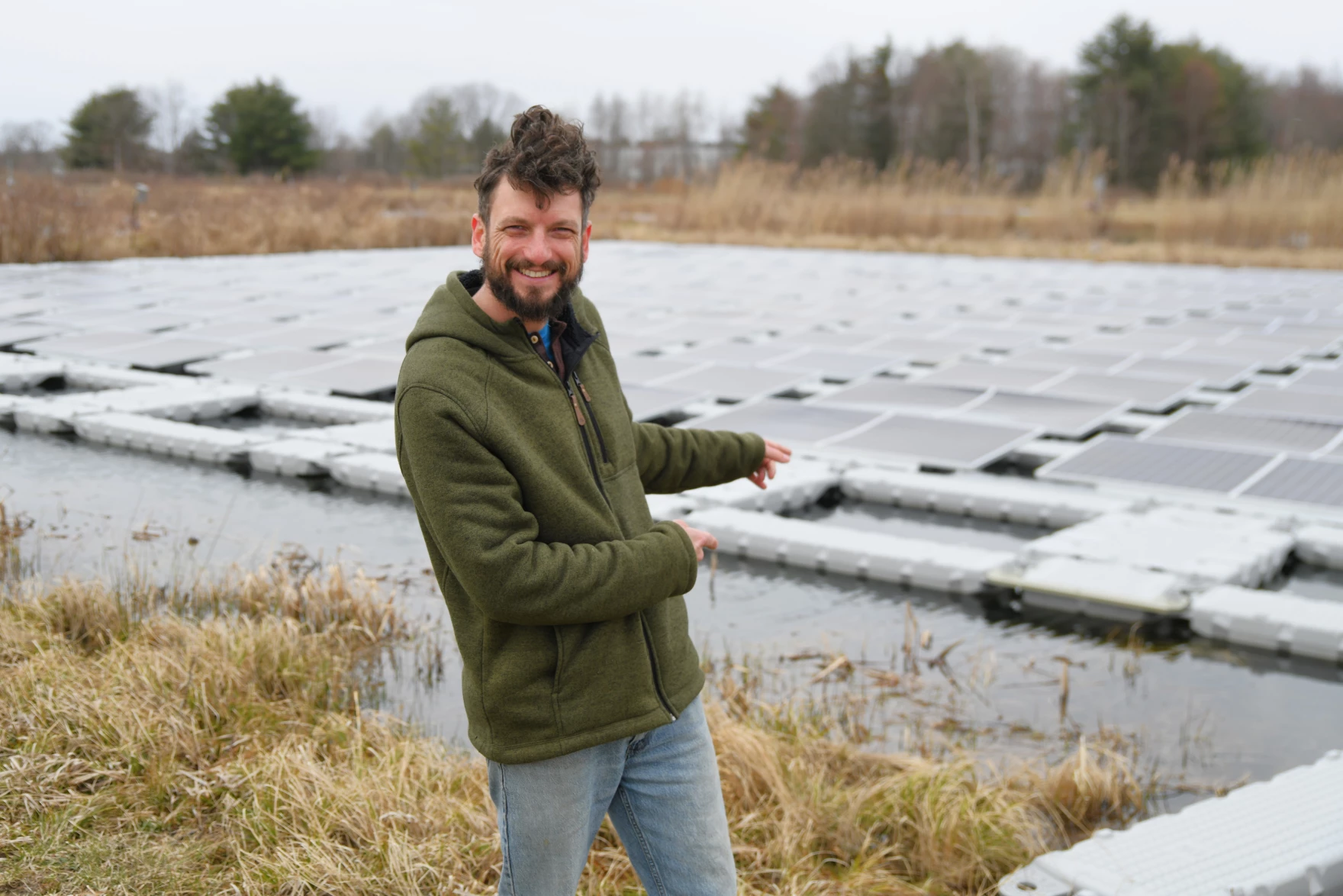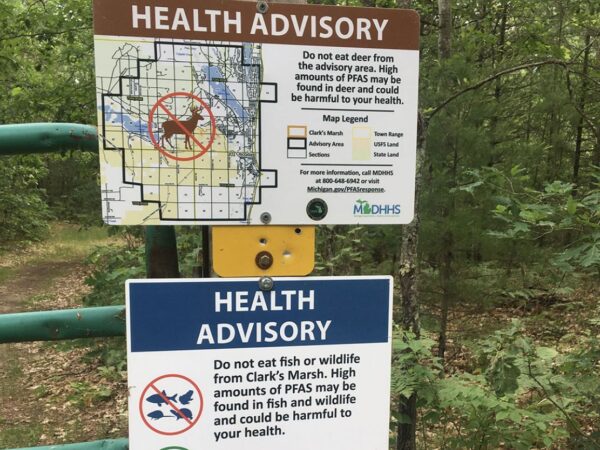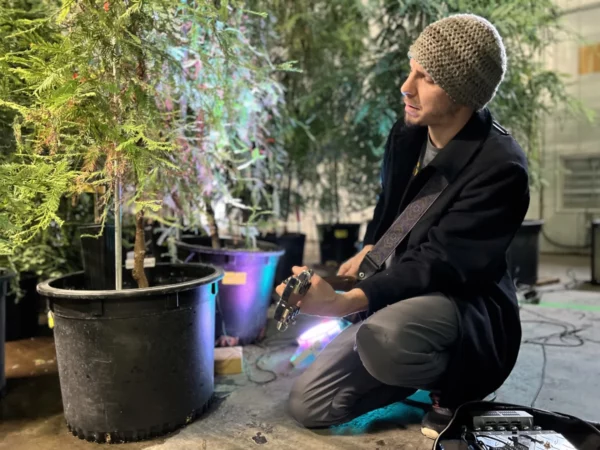
By Lester Graham and Rebecca Williams, Michigan Public
The Great Lakes News Collaborative includes Bridge Michigan; Circle of Blue; Great Lakes Now at Detroit Public Television; Michigan Public, Michigan’s NPR News Leader; and who work together to bring audiences news and information about the impact of climate change, pollution, and aging infrastructure on the Great Lakes and drinking water. This independent journalism is supported by the Charles Stewart Mott Foundation. Find all the work HERE.
A couple of Michigan communities have considered a technology that’s just beginning to be used in the U.S.
Floating solar panels.
So far, no one has a Department of Environment, Great Lakes, and Energy permit for putting solar panels on the water in Michigan, but there are plans.
Floating solar is basically solar panels on plastic rafts that are linked together and anchored to the bottom of a lake.

A U.S. Department of Energy illustration of a floating solar installation. (Photo Credit: U.S. Department of Energy)
Ann Arbor and Pittsfield Township considered floating solar as part of the plan for a solar project they pursued. But that idea didn’t make it to the final version of the Wheeler Center Solar Park.
Plainfield Charter Township north of Grand Rapids has plans for a floating solar array, but it also has some obstacles.
Township Superintendent Cameron Van Wyngarden said these solar panels last twenty to thirty years.
“We were looking to save energy, you know, in excess of $1 million over that time frame. By offsetting a significant portion of our power usage at our water plant.”
Why put solar on the water?
One of the reasons floating solar has been popular in other parts of the world is competition for land. Water offers another option for an installation.
Van Wyngarden said there were good reasons for Plainfield Township to go with floating solar at the water plant.
“We lacked other available space around it. But yet we had this open water area that made a lot of sense. It’s adjacent to the plant. It was very convenient from a location perspective. A lot of open space. No worry about tree cover or other buildings, blocking sunlight. It made a lot of sense.”

U.S. Secretary of Interior, Deb Haaland, speaking at the University of Michigan. She mentioned floating solar in her comments. (Photo Credit: Lester Graham/Michigan Public)
Some states out west have embraced floating solar panels. U.S. Secretary of the Interior Deb Haaland mentioned it when she visited Michigan back in March.
“One of the tribes decided that having a project of putting solar panels on their irrigation ditches was a way that they could keep water from evaporating so quickly while also powering the system.”
That tribe was the Gila River Indian Community in Arizona. It calls its installation the country’s first solar-over-canal project. The power from the solar array floating on the canal is used to keep the irrigation pumps operating.
What’s the downside?
A researcher in New York has been looking at what happens to a body of water when some or most of it is covered in plastic rafts topped with solar panels.
Steve Grodsky works with the U.S. Geological Survey and Cornell University.
Cornell has six research ponds of equal size. Grodsky put different sized installations on three of them. He left the other ponds alone so he could compare what happens to the ecology of those ponds.
“You know, when you mess with light availability, water temperature that can in turn have effects on things like microbes, the mixing in the ponds. And there’s sort of these bottom up effects that can manifest in terms of the plant community and aquatic insects,” Grodsky said.

Steve Grodsky pointing out one of the floating solar installations at Cornell University’s research ponds. He’s an ecologist with the U.S. Geological Survey and Cornell University. (Photo Credit: Lester Graham/Michigan Public)
On the other hand, solar panels floating on the water decrease harmful algal blooms and a reduce in evaporation.
The research is not complete, but it could be that choosing a place where people like to fish or where there are critical aquatic organisms that make up the bottom of the food web might not be the best place to float a couple of acres or more of solar panels.
But Grodsky said there are bodies of water where those concerns are not as pressing.
“You know, municipal ponds, wastewater treatment plants, there’s these kind of water bodies that I think makes sense to put them on in terms of marginalized ecological value and then using that space.”
But, it cost more than installing on land
That brings us back to Plainfield Township. It was all set for installing floating solar even though it’s more expensive than installations on the ground.
The contractor for the project, White Pine Renewables, and the township have put a pause on installing floating solar units. What happened?
Interest rates went up. Inflation went up.
Cameron Van Wyngarden said it suddenly didn’t look financially feasible.
“Yeah, at this point we haven’t completely thrown away the idea of doing floating solar. But the numbers need to work out. And right now, either the financing costs need to come back in line or the material costs need to decrease to the point where, you know, one or the other makes sense again.”
Plainfield Township is still hoping that happens because saving a million dollars over twenty years at the water plant could help keep water bills lower for their customers.
Catch more news at Great Lakes Now:
Birders flock to the Capitol to urge lawmakers to pass bills to improve the environment
Palisades “work family” reunites for shot at reopening a Michigan nuclear plant
Featured image: Cornell University’s research ponds being used to study any effects floating solar panels might have on the ecology. (Photo by Jason Koski via Cornell University)




